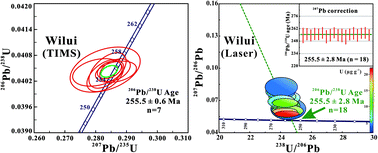In situ U–Pb geochronology of vesuvianite by LA-SF-ICP-MS†
Abstract
We present a new procedure for U–Pb dating of vesuvianite using laser ablation sector field inductively coupled plasma mass spectrometry (LA-SF-ICP-MS). Vesuvianite is a common mineral in skarn ore deposits and in metamorphic and metasomatic argillaceous carbonate rocks. The age of vesuvianite growth directly dates the formation of skarn mineralization, possibly also the metamorphism and metasomatism of argillaceous limestones. Vesuvianite U–Pb dating may provide age information for hydrothermal, metamorphic, and metasomatic processes that may be hard to get by zircon U–Pb dating. We analyzed eleven vesuvianite samples. Matrix effects were corrected by using Ti-bearing andradite (schorlomite) of known age as no well-characterized vesuvianite was available as a U–Pb reference material. The robustness of the analytical protocol was assessed by additional U–Pb dating of four vesuvianite samples by ID-TIMS. The U–Pb ages determined by ID-TIMS and LA-SF-ICP-MS agree well within uncertainties. An additional seven vesuvianite samples yielded in situ U–Pb ages that agree with previously published zircon, cassiterite, or wolframite U–Pb ages from the same area. Therefore, U–Pb dating of vesuvianite by LA-SF-ICP-MS represents a fast, relatively low-cost approach with high spatial resolution that may be particularly suited to date skarn mineralization.



 Please wait while we load your content...
Please wait while we load your content...